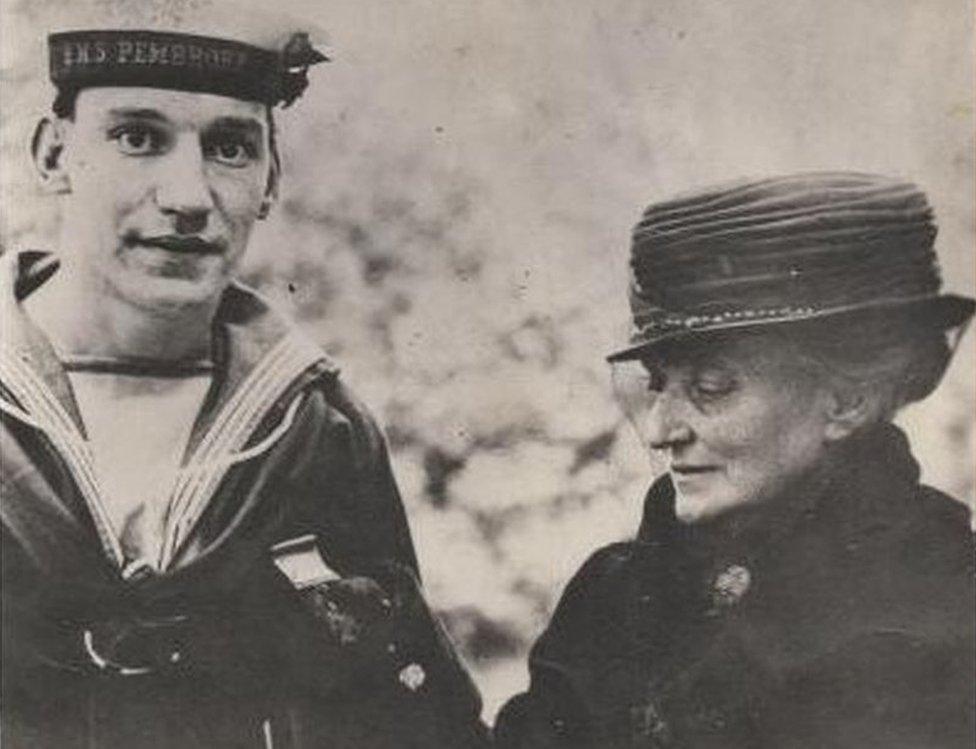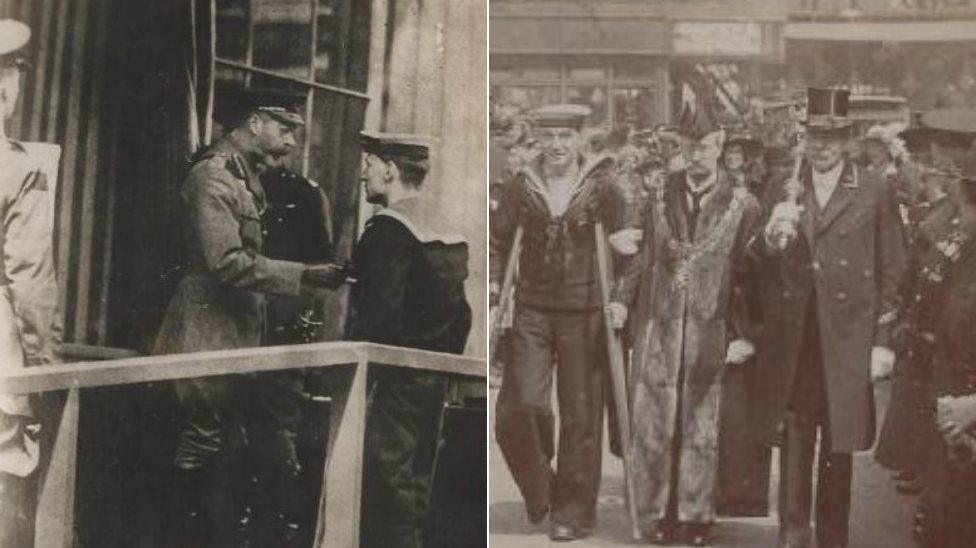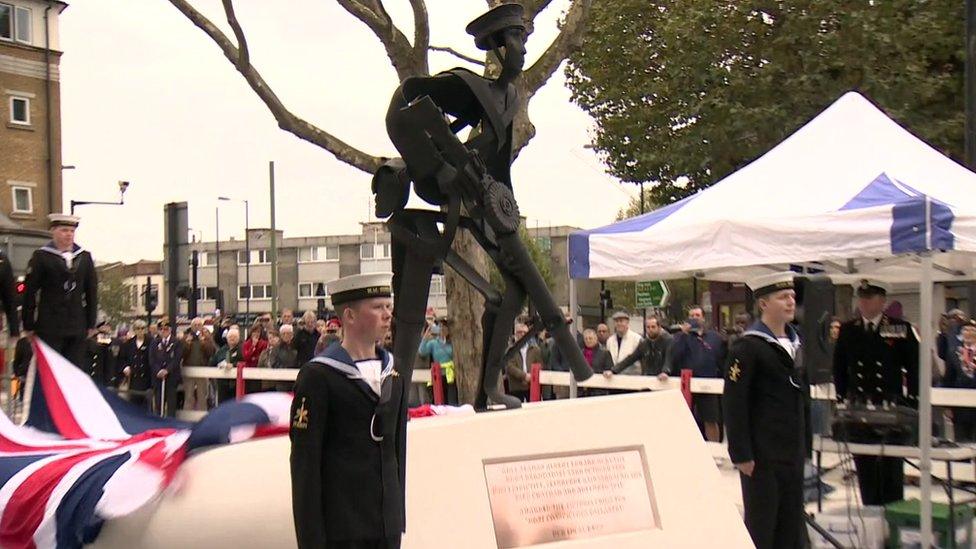Albert McKenzie: Statue honours WW1 Victoria Cross winner
- Published

Able Seaman Albert McKenzie joined the Navy as a boy and became a national hero following the Zeebrugge raid in 1918
A teenage sailor, whose bravery during the World War One Zeebrugge Raid earned him a Victoria Cross, has been honoured with a statue and 48-gun salute.
Albert McKenzie took part in a mission to block German boats in the Belgian port of Bruges-Zeebrugge in 1918.
He was one of the few among his landing party who survived the raid on 23 April and the first London sailor to collect the Victoria Cross from King George V.
His statue stands off Tower Bridge Road in Bermondsey, south London.
A stone's throw from his childhood home, the memorial sits atop a concrete plinth made from a section of the Zeebrugge harbour wall donated by the people of Flanders.
The statue was unveiled at noon as HMS Belfast, anchored in the Thames, performed a gun salute in his honour.
Able Seaman McKenzie, 19, was onboard HMS Vindictive when it entered the Bruges-Zeebrugge canal shortly after midnight on St George's Day in 1918.
The British had planned to sink three old warships, blocking the canal entrance, while detonating two old submarines to damage the port of Bruges-Zeebrugge. The idea was to prevent German submarines from leaving the port and attacking the Allies.

Able Seaman Albert McKenzie received a hero's welcome when he returned home but died in November 1918 after contracting flu
HMS Vindictive led the raid and was meant to land a storming party to create a diversion and take out the German gun positions, enabling the three British warships to get into position.
However, an ill-fated wind blew Vindictive's smoke-screen away and the German gunners inflicted heavy casualties and forced the vessel off course.
Without the smoke-screen, Vindictive's crew suffered many casualties even before it pulled alongside the harbour wall to engage the German gunners.

Excerpt from a letter Albert McKenzie wrote to one of his brothers, reproduced with permission from his family
"Well we got within 15 minutes' run of the Mole [harbour wall] when some marines got excited and fired their rifles. Up went four big star shells and they spotted us. That caused it. They hit us with the first two shells and killed seven marines. They were still hitting us when we got alongside.
There was a heavy swell on which smashed all our gangways but two, one aft [towards the stern and the rear of the ship] and one forward. I tucked the old Lewis gun under my arm and nipped over the gangway aft. There were two of my gun's crew killed inboard and I only had two left, with myself three.
I turned to my left and advanced about 50 yards then lay down. There was a spiral staircase which led down into the Mole and Commander Brock fired his revolver down and threw a Mills bomb. You ought to have seen them nip out and try to get across to the destroyer tied up against the Mole, but this little chicken met them half way with the box of tricks, and I ticked about a dozen off before I clicked.
My Lewis gun was shot spinning out of my hands and all I had left was the stock and pistol grip which I kindly took a bloke's photo with it, who looked too business-like for me, with a rifle and bayonet.
It half stunned him and gave me time to get my pistol out and finish him off. Then I found a rifle and bayonet and joined up our crowd who had just come off the destroyer. All I remember was pushing kicking and kneeing every German who got in the way.
When I was finished I couldn't climb the ladder so a mate of mine lifted me up and carried me up the ladder and then I crawled on my hands and knees inboard."

How did a young boy from the East End become a national hero?
Able Seaman Mackenzie, armed with a Lewis gun and 400 rounds of ammunition, followed his officer onto the harbour wall to fight the German forces, his family said.
He killed many German fighters and forced some of the enemy to abandon their post but by the time he was ordered to withdraw, his Lewis gun had been blown out of his hands. The talented boxer had to fight his way back to safety using a pistol, bayonet and his wit.
Speaking at the unveiling of the statue, his great-nephew Colin McKenzie said: "It's is such a huge honour for Albert to be recognised in this way.
"We've always known about Albert. We've been brought up with the stories about him, but to share that with a much wider audience in this way, is almost overwhelming.
"I've got cousins here today who were in tears earlier."

The steel statue of Able Seaman Albert McKenzie stands on a concrete plinth made from a section of the Zeebrugge harbour wall donated by the mayor and people of Flanders
During the raid Able Seaman McKenzie was wounded in the back and foot. On returning to the UK he was nominated by his shipmates to receive the Victoria Cross for bravery, presented by King George V.
A few weeks later the celebrated sailor caught Spanish flu during a global pandemic and died of pneumonia, aged 20, on 3 November 1918, days before the war officially ended.
He was buried in Camberwell Old Cemetery and a letter signed by "their Majesties" was read out at his funeral.
It read: "In the special circumstances of A.B. Albert E McKenzie's lamentable death and the fact of his being a VC, and the first London sailor to receive that most honourable reward, you are authorised to express at the public funeral the sympathy of their Majesties with the widowed mother and family.
"Their Majesties were grieved to hear of his untimely death and to think that he had been spared so short a time to wear the proud decoration which he so nobly won."
- Published7 June 2015
